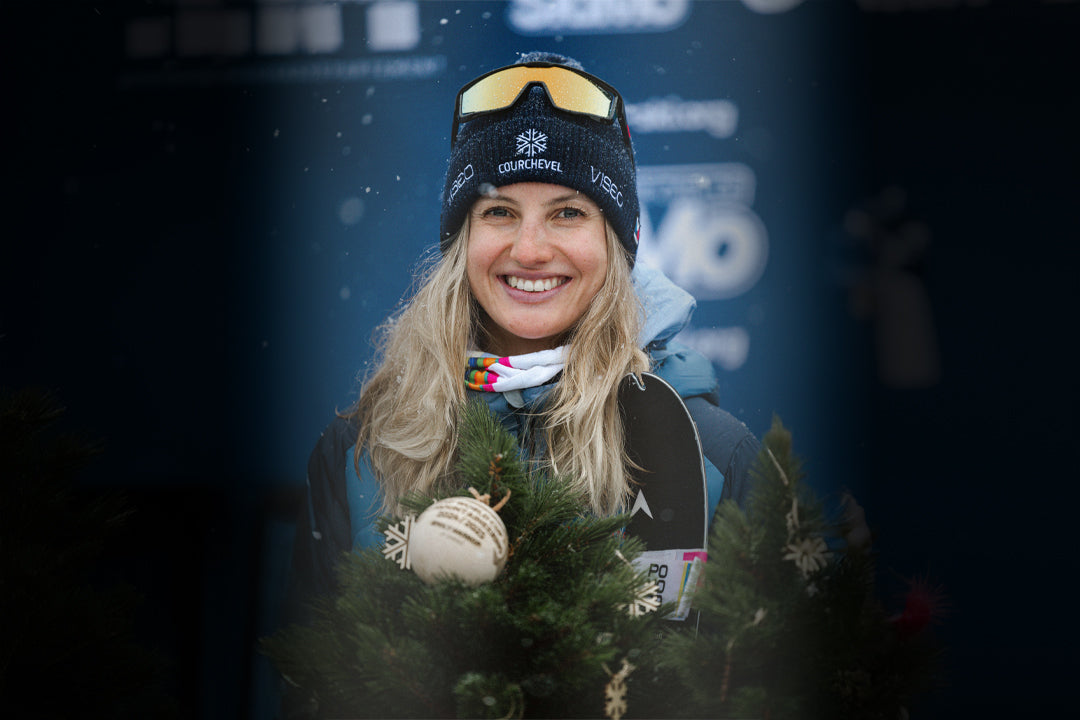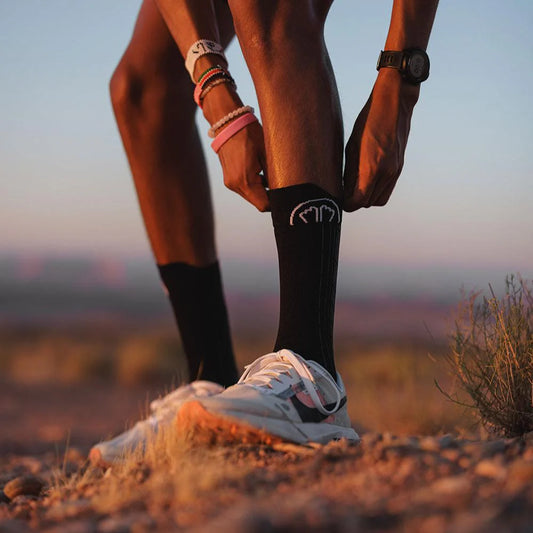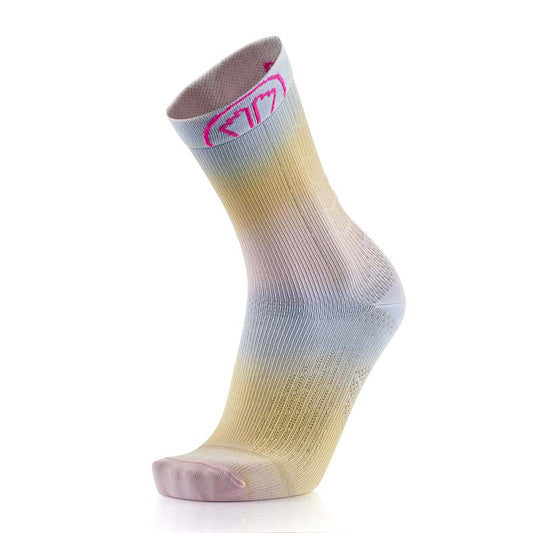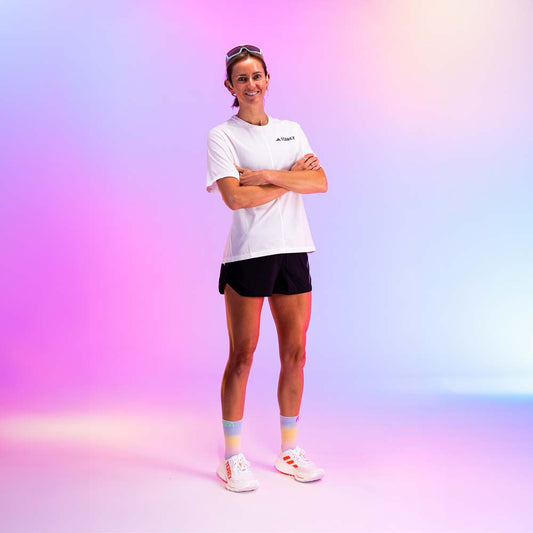An ascent with Emily Harrop, ski mountaineering champion


Four crystal globes, victories in the biggest races on the planet, and an unbroken World Cup record: Emily Harrop's trophy cabinet is certainly well stocked. What explains the young ski mountaineer's success? Exceptional talent combined with hard work, a sunny personality, deep determination and a genuine passion for her chosen terrain: the mountains. These are all factors that the Franco-British athlete will be packing in her bag as she completes her preparations for Bormio, where ski mountaineering, a spectacular and demanding discipline, will make its debut in the prestigious Olympic family. It will be a real-life test for a sport and a champion who are riding high.
We caught up with Emily Harrop in the midst of her summer preparations for the Olympics for an unusual interview in the form of 10 questions, like a ski touring ascent. Follow the guide, the one who puts style before medals!
How would you sum up last season? From an outsider's perspective, it seems close to perfection, as you were unbeatable and won every World Cup sprint event...
Emily Harrop: Obviously, the results are flattering. It seems difficult to do better from a statistical point of view. However, what makes me most proud is the process. I really felt like I had reached a new level in my career as an athlete. I approached each event not with the aim of winning, but with the idea of achieving a goal in a certain way: managing the pressure, trying out a strategy, adapting to a change in equipment, understanding different race scenarios... I wasn't necessarily looking for victories, but rather for learning, experience and new things. It motivated me deeply to expose myself to something other than pure performance. To take this step back in my approach, I surrounded myself with people. My mental trainers and coaches accompanied me on my journey of reflection and helped me understand that it was the right time in my career to make this switch. It was exciting because I felt like I was playing, having fun, and in the end, after having a blast all season, I won every round of the Sprint World Cup. It's crazy!
‘I felt like I was playing, having fun, and in the end, by enjoying myself all season long, I won all the World Cup sprint events.’
Before we start the climb, can you tell us about the origins of your passion? How did you discover this sport and what is your connection to the mountains?
I was born in Bourg-Saint-Maurice to British parents who moved to the Alps for their love of nature. So I'm half English, half French and 100% Savoyard. Given my family background, I grew up on skis, nurtured by this passion for the mountains. I started alpine skiing at a very early age, pursuing a high-level programme that took me from sports studies to the FIS (International Ski Federation) circuit via the Committee. However, repeated injuries slowed me down and after several seasons out of action, I decided to stop. Nevertheless, I always loved the physical training sessions. I excelled in these sessions, where it was all about pushing myself and going as far as possible. Growing up surrounded by sporty parents naturally led me to transfer this appetite for effort to endurance sports such as cycling and ski touring. In 2018, I pinned on my first race bibs in ski mountaineering, then in 2020, I structured my approach by hiring a coach. From there, I earned my first selections for the French national team, and since then, I've been trying to take it one step at a time...
Ski mountaineering will make its Olympic debut in a few months' time at the 2026 Games in Milan Cortina. Does this change your summer training regime compared to what you were doing before?
I've always been a fan of making a few adjustments to my preparation. The idea isn't to revolutionise everything – especially when it's working – but to progress by adding something new each year, incrementally. This also helps to avoid the risk of fatigue, to tackle this behind-the-scenes work with a fresh mind, and to fuel motivation through innovation. In practical terms, this summer, the FFME (French Mountain and Climbing Federation) is giving us more autonomy in July and August, before intensifying the training camps from September onwards. I am therefore taking the opportunity to organise my own training camp in Font-Romeu to get to know this legendary French sporting venue, before joining the team in Stelvio and Tignes, where we will be lacing up our skis again in October. We will then head to the United States at the end of November for the first round of the World Cup, with the highlight of the season being the Olympic Games in Bormio at the end of February. The real change, therefore, is not in the preparation but in the way we approach the World Cup races, which this time are seen as dress rehearsals to build confidence and develop automatic responses ahead of the Olympics, rather than as end goals.
‘The real change is not in the preparation but in the way we approach the World Cup races, which are now seen as dress rehearsals to build confidence and develop automatic responses ahead of the Olympics, rather than as an end in themselves.’
Can you describe a typical day with the French team during these Olympic training camps?
The alarm goes off at 6:45 a.m. This is followed by a hearty breakfast and a 45-minute shuttle ride to the glacier, the only place where you can find snow in autumn. We then do 3½ hours of low-intensity, endurance skiing: this is what we call “building volume” at altitude. After that, we have lunch – again with a healthy appetite but not too much, to avoid throwing up on the slopes in the afternoon – then we take a nap. At 4pm, we start the second training session of the day – the hardest and most intense – on skis or in trainers. This usually involves VO2 work, PMA (Maximal Aerobic Power) or lactic sessions. The latter are the most gruelling. They consist of a series of 20- to 30-second maximum efforts, in direct competition with teammates, with the instruction to “give it your all”! After that, we go back for treatment with the physios. Finally, there's a quick, friendly briefing about the next day's programme, dinner and a game of cards before going to bed around 10 p.m. It may seem tedious, not to say military, but for me, it's a routine that makes me happy!
"It may seem tedious, not to say military, but for me, it's a routine that makes me happy! "
The life of a top athlete is one of rigour and high standards. What specific elements of discipline in your daily life mean that your life is not entirely normal?
I'm glad you used the word “discipline” rather than “sacrifice”. Because even though this rigour requires physical and mental investment, I see it as a choice rather than a constraint. This daily routine fulfils me and makes me happy. Devoting myself to my sport, eating well, sleeping well, being in great shape and in good health is a dream life! From my point of view, the only thing that's really difficult to deal with is accepting that you're missing out on certain social occasions – not all of them, but some – with your loved ones, family or friends, and reluctantly refusing to take part because you know it will cost you more energy than it will bring you. It's part of the job! Nevertheless, I remain optimistic: I feel that with experience, you learn to identify them better!
‘The only really difficult thing to deal with is accepting that you're missing out on some enjoyable moments – not all of them, but some – with your loved ones, family and friends.’
You are number one in your discipline and therefore identified as a real chance for a French medal at the upcoming Olympic Games. How do you feel about this status? Does it put pressure on you? If so, how do you deal with it?
Since we learned that ski mountaineering would be included in the Olympics, our focus has naturally been on this event! It's a dream to be able to take part. The fact that it's about to come true is obviously exciting. Finally, we're going to see something that we've been talking about for years become a reality. Beyond this impatience, it would be a lie to say that there isn't a slight apprehension linked to the pressure. But I'm learning to manage it, little by little. I've been a favourite for several seasons now. I've made a lot of progress in that regard. I'm preparing for it, too. I think being aware of the media hype that's coming makes me attentive and vigilant, which is already a first step. I also remain very alert to the fact that I must never feel satisfied. I cultivate this phobia of waking up one day and feeling that it's all over. I run away from that feeling. I try to find the fine line between self-confidence – I am capable of doing it – and stage fright, curiosity and the desire to fully optimise my potential. This curiosity is my main shield to protect me from the pressure.
‘This curiosity is my main shield to protect me from pressure.’
This season, you won all the World Cup races, but you lost out at the World Championships. How did that second place feel? What did you learn from it?
The World Championships were my main goal for the season, along with the crystal globe, which rewards consistency and victory in the overall World Cup standings. Why? Because it was a one-day race, like the Olympics. That morning, I was beaten by someone stronger than me. Marianne Fatton proved to be smarter and more skilful in managing her effort. At first, I saw it as a failure, but I quickly bounced back and used it as a springboard for improvement. In particular, I learned to trust myself more and accept that I needed to go slower in the qualifying rounds. Sprinting in ski mountaineering isn't just about brute force! You have to be quite strategic: how do you go as fast as possible in 3-minute heats in a competition that actually lasts 4 hours?
" Have more confidence in myself and accept that I need to go slower in the qualifying rounds. "
What are your hopes for ski mountaineering's entry into the Olympic Games? How do you see your sport changing?
First of all, I hope that people will enjoy the sport and that the Olympic aura will really put ski mountaineering in the spotlight. And that the momentum generated by the sprint – my discipline – will spread to the whole sport, especially the longer events, which are closer to the original formats. If the Olympics create momentum and inspire young people to take up the sport, while respecting our fundamental values, then I will be delighted.
‘If the Olympics create momentum and inspire young people to take up the sport, while respecting our fundamental values, then I will be delighted.’
On a more personal note, what are your ambitions for these Olympic Games? Are you more focused on the process or on the medal?
I am 100% focused on the process, on the journey ahead. My ambition – sincere, deep, without any pretence – is to be able to express my full potential on the day. To do that, I need to enjoy my preparation and then go into the competition wanting to play, to give it my all, without any pressure from being the favourite. If I manage to build this positive mindset, I am convinced that a good result will follow naturally. And finally, if through this performance, the sport that I love so deeply gains recognition and inspires others to take it up, then it will be difficult to wipe the smile off my face...
Which Sidas products help you in your daily training?
Let's say that my selection changes with the seasons. During my summer training, I never take off my Run Anatomic Crew running socks. I wear them for every single session, whether I'm trail running, road running, cycling or weight training. I love how light they are and how well they fit! They're simple, precise, technical and incredibly effective. I can't wait to receive the “promodel” designed by Caitlin Fielder, because as athletes, we don't pay enough attention to the aesthetics of our socks! (Smiles) In winter, I switch to the Ski Touring women's ski touring socks, which I wear for both competition and training. They allow me to forget about my feet, not to think about any pain in my ski boots, and to focus on the here and now, which is a real bonus in terms of performance!
‘My socks allow me to forget about my feet, not think about any pain in my ski boots, and focus on the here and now, which is a real bonus in terms of performance!’
Finally, before heading off for some hot chocolate, do you have any anecdotes or routines you could share with us?
During sprint competitions, several tens of minutes can pass between the different heats. At that point, I've developed a little routine that's extremely calming. It involves breathing exercises combined with visualisation.
I imagine myself skiing at the top of Combe-Bénite – an incredible spot right next to my house – in perfect conditions with fresh snow and bright sunshine. This helps me to calm down before going back to warm up for the next round!







